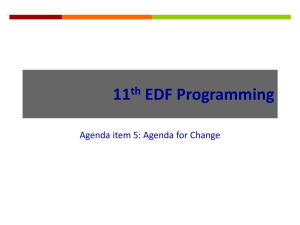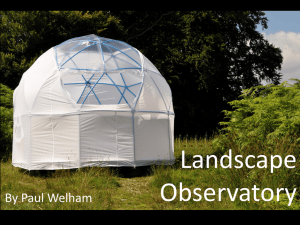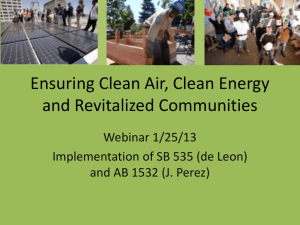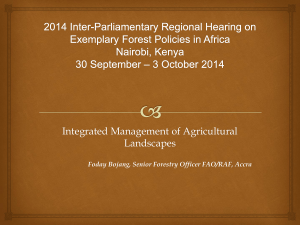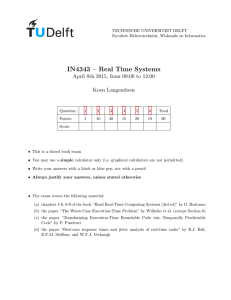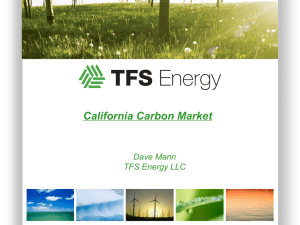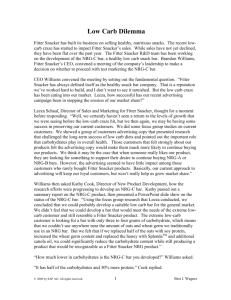Timothy O`Conner
advertisement
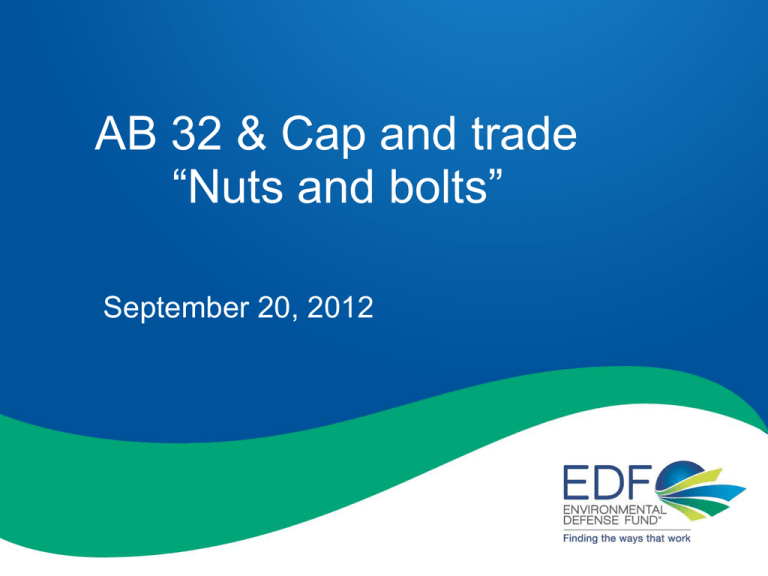
AB 32 & Cap and trade “Nuts and bolts” September 20, 2012 Environmental Defense Fund • Founded in 1967, EDF tackles the most serious environmental problems with: – A commitment to sound science – Efficient, market-based solutions – The power of unlikely partnerships – Smart, non-partisan policy • EDF was an original sponsor of AB32 and has participated in the rulemaking since adoption AB 32 in brief • Statewide climate change pollution reduction program • Requires the state achieve the 1990 emissions by the year 2020 • Includes a series of about 70 regulations and incentives based measures • Vests primary implementation authority in the Air Resources Board Benefits of AB 32 • Cleaner and diversified energy sources • Less energy wasted, saving money for people and businesses • Air pollution reductions, improved public and environmental health • New business opportunities and jobs • Transportation system improvements Greenhouse Gas Reductions by Major Category Greenhouse Gas Reduction A series of efforts across the state Enacted / In Effect • • • • • • • • • • Clean Car Standards (2004) Port drayage trucks (2007) SB 375 Regional plans (2008) Low Carbon Fuel Standard (2009) Refrigeration leak standards (2009) Landfill Methane Capture (2009) 33 % RPS (2011) Ongoing renewable programs Ongoing efficiency programs Ongoing forestry management Greenhouse Gas Reduction A series of efforts across the state In Development or Waiting for approval • • • • Cap and trade (2012) Heavy industrial audits (2012) Building efficiency (title 24) Appliance efficiency (title 26) Cap-and-trade regulation • About 18% of total AB 32 reductions • Sets a firm limit on pollution and contains flexibility to keep costs low • Individual firms get a portion of the credits they need for free, then must either reduce on site or purchase allowances or offsets • Auction starts November 2012 – compliance begins 2013 • 3 separate compliance periods • Applicable to about 320 facilities – about 85% of emissions in 2015 Cap-and-trade regulation – covered entities – Refineries – Cement Plants – Utilities – In state power plants – Imported power – Stationary sources > 25,000 tons per year – Combustion of transportation fuel (2015) – Combustion of natural gas - small sources (2015) **Renewable power has no carbon requirements California’s New Gold, A Primer on the Use of Allowance Value Created under the CO2 Cap-and-Trade Program Dallas Burtraw, David McLaughlin, and Sarah Jo Szambelan http://www.rff.org/RFF/Documents/RFF-DP-12-23.pdf The current landscape for AB 32 investment decisions: Sinclair Paint SB 1018, AB 1532 & SB 535 Administrative Agencies External Stakeholder Input The current legal landscape: Sinclair Paint (1997) and California Farm Bureau (2011) • Cal. Sup. Court 1997 - Sinclair Paint Co. vs. State Board of Equalization, (interpreting California’s Prop 13). • Revenues generated from a regulatory fee must have a close connection (nexus) between the purpose of the fee and the way the revenue is spent. • Cal. Sup. Court 2011 - California Farm Bureau Federation v. State Water Resources Control Board • A government agency should be accorded some flexibility in calculating the amount and distribution of a fee The current landscape: AB 1532 Principles 1. Reduce GHG’s (Threshold requirement for all investments) 2. Maximize economic, environmental, and public health benefits 3. Foster job creation [in California] 4. Improve air quality. 5. Help disadvantaged communities and households 6. Provide opportunities for businesses, public agencies, nonprofits, and other community institutions 7. Lessen the impacts and effects of climate change The current landscape: AB 1532 Suggested Projects to reduce GHGs 1. EE, CE/RE, DG, Transmission, Storage – at public universities, state buildings, and facilities. 2. Goods movement, vehicles, fuels, and public transit 3. Water efficiency, natural resource conservation and management, forestry, and sustainable agriculture. 4. Strategic planning and development of sustainable infrastructure 5. Waste reduction, diversion, and reuse. 6. Local and regional programs 7. RD&D of innovative technologies, measures, and practices. The current landscape: AB 1532 Investment Plan The investment plan shall: 1. ID near-term and long-term reduction goals by sector. 2. Analyze gaps in current state strategies to meet reduction goals by sector. 3. Identify priority investments that will facilitate the achievement of feasible and cost-effective GHG reductions The current landscape: SB 535 Requires a minimum of 25% of CARB’s auction proceeds to be used in ways that benefit disadvantaged communities, either directly or indirectly. It also requires a minimum of 10% of auction proceeds directly fund projects within those communities. Role of Governor, DOF and CARB: State Budget and AB1532 1. Governor Brown has set aside money for GHG reduction projects that also reduce general fund expenditures 2. DOF, on behalf of the Governor, and in consultation with CARB and any other relevant state entity, shall develop and submit to the Legislature 3. CARB shall hold at least two public workshops in different regions of the state and one public hearing. 4. CARB must consult with the CPUC 5. Climate Action Team shall also provide information Role of External Parties 1. Participation in official public consultation processes (AB 1532) 2. External contact with DOF and agencies 3. Participation in CPUC process EDF investment advocacy: Profiling sample investment categories Directly Helping California Businesses Grow Providing energy efficiency and clean energy financing directly to regulated and unregulated businesses Supporting Local Communities Investing in municipal projects that make air quality better, improve, quality of life, and cut local expenses to save taxpayers money Better Transit and Transportation Improving road quality, relieving traffic congestion and increasing the availability of low-carbon transit and transportation Improving schools and hospitals Making upgrades that create good paying jobs and cut energy bills Thank You Tim O’Connor Director, California Climate and Energy Initiative toconnor@edf.org Office: (415) 293 - 6132 Cell: (916) 549 - 8423


